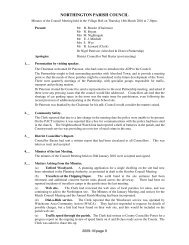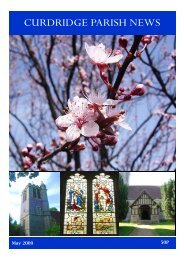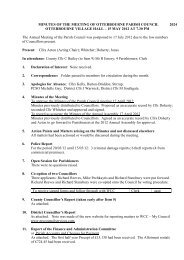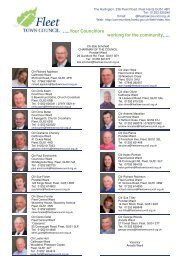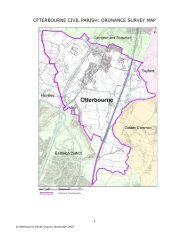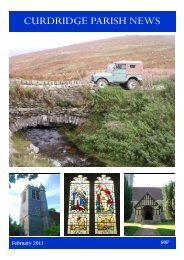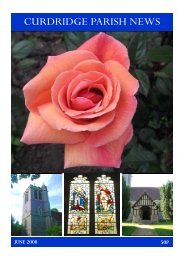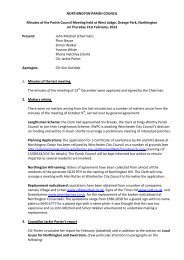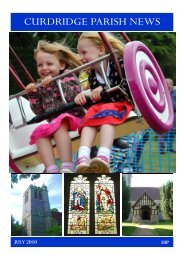March 08 Curdridge Parish News - Hampshire County Council
March 08 Curdridge Parish News - Hampshire County Council
March 08 Curdridge Parish News - Hampshire County Council
Create successful ePaper yourself
Turn your PDF publications into a flip-book with our unique Google optimized e-Paper software.
WILDLIFE INFORMATION<br />
A world outside your window<br />
<strong>Hampshire</strong> is home to a wonderful variety of mammals<br />
and with such a fascinating mix on our doorstep, here<br />
is a short introduction to some of our wildlife<br />
neighbours.<br />
Insectivores are small mammals whose diet consists of<br />
insects and other invertebrates. They are mostly nocturnal,<br />
solitary animals with poor eyesight but a keen<br />
sense of smell and a long sensitive snout. There are six<br />
species in the UK, including shrews, moles and hedgehogs.<br />
Did you know…As moles find it hard to turn around in<br />
narrow tunnels they hold their tail upright and use it as<br />
a ‘feeler’ to detect what is happening behind as they<br />
travel backwards.<br />
Chiorptera means ‘handwing’ and bat wings are in fact<br />
enlarged hands with elongated fingers covered by a<br />
thin membrane of skin. Bats are nocturnal and use a<br />
highly specialised navigation system called echolocation;<br />
they produce a high-pitched sound that humans<br />
cannot hear; each species of echolocates in a different<br />
way and at a different frequency.<br />
Did you know…Serotine bats are able to skilfully eat<br />
large insects while in flight, by manipulating the insect<br />
in their jaw and dropping the inedible parts to the<br />
ground.<br />
Rodents. In Latin, ‘rodere’ means to gnaw, and gnawing<br />
their food is the one thing that distinguishes rodents<br />
from all other mammals. They have distinctive front<br />
teeth, called incisors, that never stop growing so they<br />
have to gnaw constantly to stop them from becoming<br />
too long. Rodents in the UK include squirrels, rats,<br />
mice, voles and dormice.<br />
Did you know…Grey squirrels are capable of running<br />
easily up and down trees thank to their strong claws<br />
and ‘double jointed’ ankles, which allow their feet to<br />
face forwards or backwards.<br />
Carnivores comes from the Latin word which means<br />
meat-eating. A carnivore’s diet is therefore mostly<br />
made up of meat and their teeth are well adapted for<br />
stabbing and tearing meat but not for chewing it.<br />
Carnivores are mostly nocturnal, secretive mammals and<br />
are very efficient predators. They include the fox,<br />
badger, otter, stoat and weasel.<br />
Did you know…Otters mark their territory with their<br />
faeces, known as spraints. These spraints have an<br />
unusual sweet, musky smell that some people<br />
compare to the smell of jasmine tea!<br />
Artiodactyls are large herbivorous mammals, which<br />
all have hooves that are divided into two and leave<br />
distinct footprints. As well as deer, artiodactyls<br />
include pigs, cattle, sheep and goats. Almost all adult<br />
male deer grow a pair of antlers which they shed<br />
annually, usually in spring, and then re-grow within<br />
3–4 months. New antlers are covered by a thin layer<br />
of velvety skin, which protects and nourishes them.<br />
When the antlers are fully grown, the skin dries up<br />
and the deer rubs it off by scraping them against<br />
trees.<br />
Did you know…When males shed their antlers, it is<br />
hard to tell the difference between male and female<br />
roe deer. The best way is by looking at their rump.<br />
Females have a white patch of fur in the shape of an<br />
ace of spades whereas the males is kidney-shaped.<br />
Lagomorphs are herbivorous mammals, which have<br />
large chisel-like front teeth that are constantly growing<br />
and being worn away. We know them as rabbits and<br />
hares. From a distance they look similar, but hares<br />
are bigger, have longer legs and ears and do not burrow.<br />
Did you know…A mother rabbit makes a special<br />
nursery nest out of grass and moss, and lines it with<br />
hairs plucked from her own chest.<br />
For further information please contact; <strong>Hampshire</strong><br />
and Isle of Wight Wildlife Trust on 01489 774400 or<br />
visit www.hwt.org.uk.<br />
Roe Deer photographed by Phil McLean



